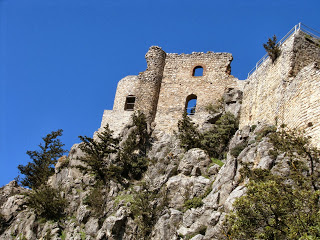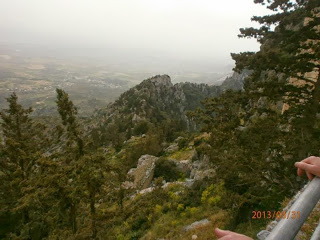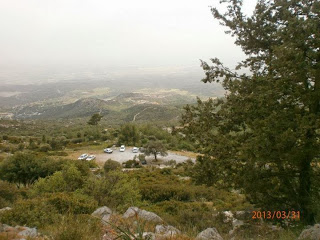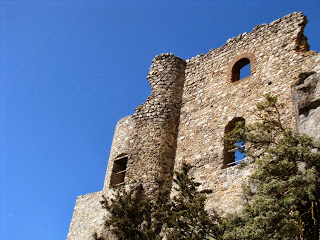By Zina Lysandros Panagidis,
Philologist, MSc:
Woe is me. Pity great. To see Boufavento again. I was also very moved by the story of his queen, Maria de Molino, about whom I wrote in the first years of our exile, when I wrote texts about our occupied land on the state radio that produced but also preserved our culture and identity elements. us.
On Sunday, March 31, 2013, the dream finally comes true. Together with good friends, we turned from the main road of Nicosia, Famagusta, somewhere before Mia Milia, and headed north. This road leads to Dikomo.
However, in a few minutes, we turned right for the Mountain, the "village of widows", where the widows from Tochni live, after the heinous and cruel crime of some of our brainless people, and Syghari, just below the Turkish flag that shakes our nights. Almost united, our two beautiful villages are perched at the foot of the mountain. The scenery is beautiful, but our hearts are tightened at the sight of the monster that is across from us. It is equivalent, we have heard, to twelve football fields. We were also told that a soldier working on its construction fell and was killed.
We follow a narrow road that leads to the castle of Vufavento. We greedily look around the vegetation, but it is not as orgiastic as in the other ridges of Pentadaktylos, Akanthou and Kandara, which we are more familiar with.
In front of us, images of our past life pass, when we ascended from Kythrea upwards, and climbed like deer towards the castle. In a short time, we arrive at a picnic area, where many people cook their skewers. We comment on how much we look like the Turkish Cypriots, and in this habit.
Immediately to our right, the church of Panagia Absinthiotissa stands out. We will see her back. After a few more ribbons of the mountain, we stop at a plateau, and just above us the ruined castle stands majestically on top of the steep and towering cliffs.
Immediately, prima vista, we understand that the ascent will not be as easy as in the castle of Agios Hilarion. There are no facilities here like there, where you can hold on to the railing. Here, they have not used it at all for tourism.
From the beginning, things are difficult. We are constantly struggling. That's why we make many small stations, rest for a few minutes, gaze at the view of the plain and take the necessary photos. The day, however, is inappropriate, since the dust covers everything.
At one point, we enter the entrance of the castle, where they make sure to inform us with a wall sign that this castle was taken from us in 1974. Immediately in front of us is the first building, a large hall, probably the remains of a stable that worked outside from the castle. There is also a tank.
Above a second level, there are half-ruined buildings, among them a large vaulted room with two tanks on the floor.
As I sat to breathe, just before ascending to the third zone, I enjoyed the view that stretched beneath my feet.
Going up a staircase that is partly carved into the rock, we reach the last level, the highest point, where there were three building complexes. In the center of this zone is a rectangular building from the Lusignan era which may have functioned as a chapel.
On the floor of the largest room there are two tanks that collected rainwater that ran from the flat roof through vertical water pipes. There is a tank in the second room and a third (outdoor) tank is located outside the north precinct of the castle. The north wall of these rooms extends to the west and includes a narrow platform from which fire signals were probably transmitted to Nicosia and Kyrenia.
However, constantly, during the ascent, some people measured 595 steps, we said that the regina would be carried by the servants on an armchair, while we panted to climb these 954 meter high peaks, which make it the second highest mountain. in the Pentadactylus and one of the most invincible.
At some point, you look at the entire northern sea, the sea of Cilicia and understand why this castle was so strategically important, like the others in the Pentadaktylos mountain range, built in the late 11th and early 12th centuries, after watching the movements of ships and signaled the capital with traffic lights. At that time Cyprus was very important for the Byzantine Empire from a political and military point of view, since almost the whole of Asia Minor had been occupied by the Seljuk Turks.
The fortress was used by the Franks as a fortress, as a marking station and as a prison, while the Venetians destroyed it, as well as the others, after 1529, in order not to let the enemies use them.
The descent was obviously much easier. Although there are many steps, these alternate with concrete paths that make walking easier. Unfortunately, however, the trails are a place of defecation for their living, creating an alginate impression on the visitor.
So we went down, thanking God and Saint Chrysostom, whose monastery is below and its foundation is connected with the castle. I have always loved the story of this Venetian lady, Maria de Molino, who, excluded due to leprosy, built the monastery of St. Chrysostom on the castle of Boufavento, after her miraculous healing, a little further down, in the village of Koutsoventis .
What had happened; Together with his wife he became ill with leprosy and her dog, her only companion, who left, and when he returned shortly after, he noticed that he began to heal. Then the lady sent her servant to see where the dog was going. And he discovered that this was washed in a spring, under the mountain. So the lady was washed, and she was well. When it came time to go down to the city to live with her family, on the eve of her departure, St. Chrysostom appeared in her sleep and told her to build a monastery in his name and spend the rest of her life there. So it happened.
In a short time she built the monastery, brought monks, endowed it with a lot of land and money, and stayed there all her life.
The monastery of St. Chrysostom, which is an exarchate of the Patriarchate of Jerusalem, is inaccessible to us today, since after being looted by the Turkish occupation forces, it is used as a camp, and is a forbidden military zone.
We, however, keep it in our memory intact, as it was then, since we visited it many times, because we used to baptize children there or go on excursions. The monastery is famous for its source which cures skin diseases.
After Voufavento, in the west, near the village of Syghari, on our return, we stopped at the monastery of Panagia Absinthiotissa. Desolation and desecration. Stable for animals. Their shelter. The surrounding buildings, ruins. Knives in the heart.
This monastery is one of the most important of the Byzantine period. It took its name from a bush, the wormwood, which well covered the mouth of the cave, in which a monk, to save, from the fury of the Iconoclasts, hid the image of the Virgin Mary. Later, when the images were restored, residents at this point saw a strange light shining. They found the icon of the Virgin Mary and built the monastery which, as it is testified, had a large fortune during the Venetian period. It even included the two villages, Vouno and Syghari. However, during the Turkish occupation of our island, it lost its autonomy and became part of the Holy Sepulcher and part of the monastery of St. Chrysostom.
With the invasion, the icons were stolen and the frescoes of the Monastery of the 12th - 14th century were destroyed, and today they are discovered in European antiquities markets.
We leave with a heavy heart from the once beautiful monastery of Panagia Absinthiotissa, and do what we have left. What is our only consolation in these discrete years of our refuge. We pray to Our Lady and Saint Chrysostom to do their miracle. To pity our people. Because, we firmly believe that our Saints are there and are waiting for us to return first to our faith and then to our land.






